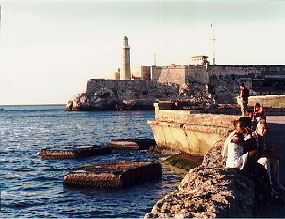 ESSAY
ESSAY
7 Days in Cuba
July
1997
by David Speranza
(photos by the author)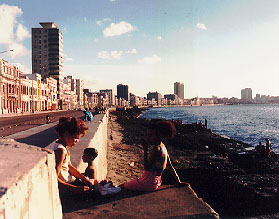
Cuba has generated more than its share of news
lately. What with hotel bombings, jailed reporters, violations of the
U.S. trade embargo, the Pope’s January visit, and periodic reports of
Fidel Castro’s long-awaited death, the tiny Caribbean nation seems to
be entering a new period of turmoil in its much-troubled history.
But along with so much unrest, the country has been attracting
something else: tourists. In fact, tourism has become the nation’s
leading industry. Americans, of course, are more or less forbidden by
the U.S. government from traveling or spending money there (I went by
way of Canada). But for those vacationers fortunate enough to visit
this neglected Caribbean nation, the rewards go beyond a good tan and
pockets full of unusually white sand.
For many travelers, even outside the U.S., Cuba remains something of a
mystery. Its former tug-of-war status between the United States and the
Soviet Union—with Fidel Castro as shrill, bearded referee—has long
painted it as inhospitable to visitors from more developed nations.
Even today, six years after the Soviets closed up shop, American
policymakers continue to portray Cuba as nothing short of Hades, and
Castro as the devil himself.
But the world has changed since 1989, something the U.S. State
Department, even under Clinton, doesn’t seem to fully understand. With
communism no longer a world threat, tiny Cuba, once a fearsome conduit
of Soviet arms and ideology, has been cut adrift, its commitment to
communism seeming less a threat than the quirky preference of an aged,
stubborn leader too proud to realize history has passed him by. But
give Fidel credit: He has
tried to loosen the reigns a little. With the Soviets no longer the
country’s primary trading partner, he’s been forced to take such
unrevolutionary steps as allowing his citizens to possess U.S.
currency, and even (with limitations) go into business for themselves.
Canadians and Europeans already know this. They’ve been visiting the
island—and in the last year or so, investing in it—for some time. And
they’re more than happy to ignore the U.S. grudge against Castro,
positioning themselves for the day when the Bearded One passes on and
America is left playing economic catch-up.

But while the western powers bump elbows in preparation for
that fateful day, there remain any number of pleasures vacationers can
take on Cuba’s tropical shores. Aside from the usual
activities—sunbathing, surfing, diving, spelunking—what separates this
country from other Caribbean vacation spots are its unspoiled lands and
its poignant sense of history. It’s hard not to be moved by the sense
of world events impacting on daily lives here, beyond the rhetoric of
ideology and politicians trying to prove whose system is right.
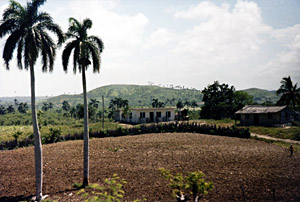 This
was apparent soon after I stepped onto the baked tarmac of the tiny
airport in Varadero and breathed in the thick, moist July air. As my
traveling companion and I hitched a ride on a tour bus to the center of
town, what struck me most weren’t the palm trees, the ocean, or the
banana fields—all of which I’d expected—but rather the complete absence
of billboards for McDonald's, Marlboro, or Coke. It made complete sense
given the harshness of U.S. policy, but it was odd not having those
ubiquitous beacons of capitalism greeting us as we left the airport.
For once I truly felt I was "getting away from it all." (Though we
later discovered that Coke, and even Marlboro, are
available in Cuba—they're simply not advertised. The Cokes came from
Mexico; no telling where the Marlboros came from.)
This
was apparent soon after I stepped onto the baked tarmac of the tiny
airport in Varadero and breathed in the thick, moist July air. As my
traveling companion and I hitched a ride on a tour bus to the center of
town, what struck me most weren’t the palm trees, the ocean, or the
banana fields—all of which I’d expected—but rather the complete absence
of billboards for McDonald's, Marlboro, or Coke. It made complete sense
given the harshness of U.S. policy, but it was odd not having those
ubiquitous beacons of capitalism greeting us as we left the airport.
For once I truly felt I was "getting away from it all." (Though we
later discovered that Coke, and even Marlboro, are
available in Cuba—they're simply not advertised. The Cokes came from
Mexico; no telling where the Marlboros came from.)

Varadero’s beaches, as the guide books promised, were
beautiful—white sand, warm emerald waters, placid waves—though not as
well maintained as, say, Mexico's (the lack of Coke signs was more than
made up for by the many crushed soda cans littering the sand). But
aside from the beaches, there was surprisingly little of note in
Varadero. It's a resort town, in many ways like other resort towns only
a bit more rundown. In fact, much of it is indistinguishable from parts
of first world and other developing countries. Aside from the scarcity
of billboards (and the terrible waiters), you'd hardly know it was
communist.
Most of what caught my eye in Varadero were the small, incongruous
touches: the oil derricks pumping rhythmically into the earth just
outside town; the lone smokestack to the west spewing flames into the
atmosphere, causing nighttime clouds to throb orange from within and
the air to reek of sulfur; the large set of rusting bleachers
dominating an entire block along the main street—presumably in
anticipation of some state-sponsored parade; the hotel TVs, most of
whose channels were devoted to English-language (and usually American)
programming—CNN, VH-1, HBO, etc.—in a country spurned by America; the
families of Cubans visible through the open windows and doors of their
houses at night, rooted to their living rooms by the gray glow of a
television, a single (surplus?) family member seated outside, gazing in
through a window or door, equally transfixed, equally unmoving.
And the cars.

Cuba's cars, if they aren't already legendary, should be. The
country is crawling with vintage American monsters from the 1940s and
'50s: great bloated finned things with steering wheels the size of
tires and rear lights poking up on stalks like the eyes of a great tin
lobster. Beautiful extinct beasts inhabiting a Detroit version of
Jurassic Park. 
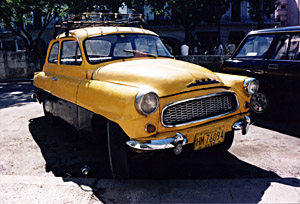
Besides their number (you'll see at least one on every block),
what makes them so intriguing is how lived-in they are. These are not
the gleaming, spit-polished, Turtle-Waxed museum pieces glimpsed in
period films or car shows; these are cars that have been used nearly
every day since first rolling off the production line. They're
battered, they're rusting, they've got holes punched in their sides,
windows cracked, and many have more layers of paint on them than the
ceiling of a Brooklyn brownstone.

Of course, there are exceptions—cars which their owners take
more than customary pride in, and which (more importantly)
they can afford
to keep in decent shape. But even these retain the air of
something functional as opposed to decorative: you sense they've been
passed down from one generation to the next with loving care. But
polished or rusting, the sight of a two-toned Buick lumbering around a
corner never fails to draw appreciative gasps from even the most jaded
foreign visitor.
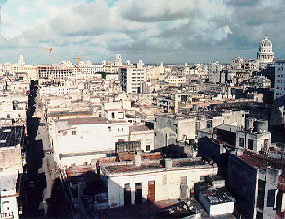
After three days of
tanning in Varadero, we decided to take a bus to Havana—a city that’s
seen better days. Though touted as the greatest repository of preserved
Spanish colonial architecture in Latin America, the problem starts with
how one defines “preserved.” Yes, the city is a veritable museum of
18th and 19th century buildings. But only if you mean a museum that's
been bombed. Communism never looked so bad. According to my fellow
traveler, who works in war-ravaged Bosnia, the city appears in worse
shape than Sarajevo. Buildings and streets are crumbling
everywhere you turn, leaving the 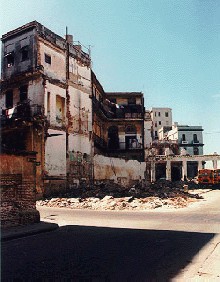 whole
of Central Havana looking like a dingy gray skeleton or piles of
broken, poorly cleaned teeth. Reportedly 300 or so buildings collapse
of their own accord each year, and the streets contain enough rubble to
prove it. When democracy finally does come to Cuba, someone's going to
make a hell of a lot of money
whole
of Central Havana looking like a dingy gray skeleton or piles of
broken, poorly cleaned teeth. Reportedly 300 or so buildings collapse
of their own accord each year, and the streets contain enough rubble to
prove it. When democracy finally does come to Cuba, someone's going to
make a hell of a lot of money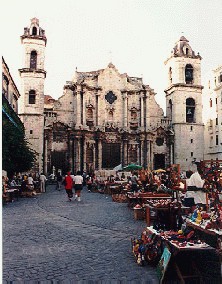 selling paint.
selling paint.
Yet the occasional restored gem does pop up, especially in Old Havana,
a small, tourist-oriented district which seems to have garnered the
bulk of the city's restoration funds. There are churches and parks and
restaurants and museums (including a car museum)—even a privatized
outdoor market set inside a large cobbled square—all looking as spiffed
up as any you'll find in the developing world.
But in the less fortunate areas—i.e., most of the city center—the only
hope for restoration seems to come in the form of the scattered private
businesses allowed to operate in Cuba since 1993. The most promising of
these are the paladars—privately
owned restaurants, usually based in someone's home and allowed to seat
no more than 12 guests at a time (thus ensuring less competition for
the state-owned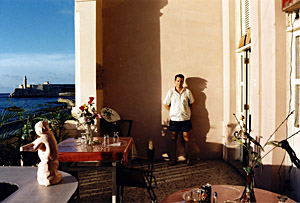 restaurants). Despite this handicap, these tiny establishments are
flourishing. One that my travelmate and I dined at was located on a
second-floor balcony overlooking Havana’s glittering harbor, and though
it only had two tables, it stood out from the many crumbling buildings
around it by virtue of its painted and restored facade. The walls were
mended, the glass replaced, the paint freshened—making it a tiny
capitalistic oasis in a sea of fading communism. Not only was the meal
excellent, it was cheaper than most of those we ate elsewhere.
According to the owner, a patient, cheerful woman of African descent,
the place has been doing excellent business since opening two years
ago. And though I forgot to ask, I wouldn't be surprised if the
adjoining building, also restored, belonged to her as well.
restaurants). Despite this handicap, these tiny establishments are
flourishing. One that my travelmate and I dined at was located on a
second-floor balcony overlooking Havana’s glittering harbor, and though
it only had two tables, it stood out from the many crumbling buildings
around it by virtue of its painted and restored facade. The walls were
mended, the glass replaced, the paint freshened—making it a tiny
capitalistic oasis in a sea of fading communism. Not only was the meal
excellent, it was cheaper than most of those we ate elsewhere.
According to the owner, a patient, cheerful woman of African descent,
the place has been doing excellent business since opening two years
ago. And though I forgot to ask, I wouldn't be surprised if the
adjoining building, also restored, belonged to her as well.

Our first night in Havana included a lengthy walk through the city's
humid center, exploring many a darkened nook and cranny. Central
Havana's basic design seems to consist of densely packed, crumbling
buildings whose rusted terraces continually threaten to drop onto the
wide, poorly lit streets below. These streets may be no wider than the
average North American street, but because of the small number of
parked vehicles along their curbs, they seemed unusually large. More
prominent than the occasional car were the occasional trash dumpster
and occasional pile of rubble.
And the Cubans, of course: seated bodies inhabiting doorways and street
corners, mostly young men with nothing better to do and no cooler place
to do it; visible in patches beneath murky shadows, almost subliminal,
until suddenly one grins and calls out to you, holding both hands out
in front of him as if measuring something, but in fact indicating a
desire to sell cigars. And the families: visible along nearly every
street, inert within their first-floor apartments, in requisite groups
of three or four and, just as in Varadero, perched before their
televisions, a stray neighbor or relative peering in from outside.
Windows, curtains, and doors seemed nonexistent, replaced by
elaborately wrought iron gratings more reminiscent of cafe or
restaurant decor than someone's home. The family dogs lurked just on
the fringes, in alleys and doorways—scrawny mongrels no bigger than
inbreeding and nutrition would allow. Friendly and passive, they seemed
to bark more from boredom and heat than anything else.
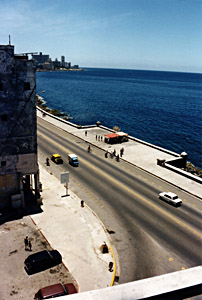 Havana
is a truly surreal place, like something Rod Serling might have cooked
up during an especially vivid fever dream. Its streets seem filled with
rejects and castoffs from the rest of the world, like a great dumping
ground for obsolete consumer goods—as if an entire city had been
outfitted at an international rummage sale. The range of periods and
technologies visible on any street corner would actually be charming if
it wasn't the product of such a diseased system. BothSpanish ballads
and Western disco blare for attention from plastic, tinny speakers
perched amid parrot-decorated cafes, while massive 1950's
automobiles—some gleaming, others coughing their last—pass in front of
Spanish colonial buildings, blocky communist hotels, and even a
Havana
is a truly surreal place, like something Rod Serling might have cooked
up during an especially vivid fever dream. Its streets seem filled with
rejects and castoffs from the rest of the world, like a great dumping
ground for obsolete consumer goods—as if an entire city had been
outfitted at an international rummage sale. The range of periods and
technologies visible on any street corner would actually be charming if
it wasn't the product of such a diseased system. BothSpanish ballads
and Western disco blare for attention from plastic, tinny speakers
perched amid parrot-decorated cafes, while massive 1950's
automobiles—some gleaming, others coughing their last—pass in front of
Spanish colonial buildings, blocky communist hotels, and even a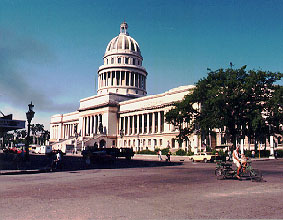 near-duplicate of the U.S. Capitol. The wheeled conveyances
alone are enough to make one blink: along with the already mentioned
American relics, there are British Vauxhalls, Russian Ladas, Czech
Skodas, Polish Fiats, and a strange variety of six-doored taxicab,
possibly from South America. Equally numerous are the fleets of
heavy-fendered bicycles, rickshaw-style pedicabs, and a shocking number
of motorcycles with sidecars, including some pre-communist Czech Jawas.
near-duplicate of the U.S. Capitol. The wheeled conveyances
alone are enough to make one blink: along with the already mentioned
American relics, there are British Vauxhalls, Russian Ladas, Czech
Skodas, Polish Fiats, and a strange variety of six-doored taxicab,
possibly from South America. Equally numerous are the fleets of
heavy-fendered bicycles, rickshaw-style pedicabs, and a shocking number
of motorcycles with sidecars, including some pre-communist Czech Jawas.
Probably the most bizarre vehicles are Havana's public buses, huge
diesel-spewing creatures called Camels. These look nothing like the
popular conception of a bus, comprised as they are of two parts: the
front section, identical to the tractor part of a tractor trailer, and
the back, or “trailer” section, a long, boxy carton humped on both ends
and dipping in the middle (thus the name “Camel”). Most of the time
these people-carriers are packed with an alarming number of passengers,
all appearing quite uncomfortable, squinched up against each other and
looking desperate to be somewhere else. I can only imagine the levels
of heat and carbon dioxide stewing inside those rumbling beasts.
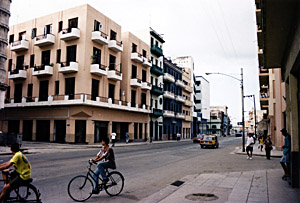
The people themselves (66% Spanish, 22% mulatto, 11% black, 1%
Chinese), seemed quite friendly, with no apparent malice towards evil
imperialist Americans. In fact, many appeared pleased to hear where I
was from, usually countering with, "I have a brother/sister/uncle
living in Miami/New York/Tennessee." But most of our conversations with
Cubans usually involved four basic variations:
"Taxi?"
"Cigars?"
"Where you from?"
"Italiano? Francais?"
That is, unless they were kids, in which case the standard salutation
was a snake-like "Tss!" Which translated as: "Turn around so I can
grope you and ask for money."
That was how most of our conversations started. This is how they ended:
"No thanks, we want to walk."
"Gracias, no."
"No Italiano. Canadian. American."
"We've already got cigars, thanks."
"No moleste, por favor."
The 'moleste'
became especially acute whenever I went out with a camera dangling
around my neck. No dummies, these Cubans.

As we walked, we found that shops in the more commercial blocks ranged
from vacant and ghostly to vibrant and adequately stocked, depending on
the level of tourism in the area. The less touristed streets seemed the
epitome of bare-shelved communist chic, the goods on display continuing
the hand-me-down tradition of the city's vehicles. The shelves of one
rather sparse shop window offered the following merchandise to whet
one’s appetite: a hair dryer, three or four portable tape decks, a can
of shoe polish, hairpins, portable clocks, and a large plastic bottle
of some clear blue fluid (ammonia? liquid Drano? radiator fluid? I
certainly couldn't tell). I also couldn't tell if the items were new,
used, or simply permanent display items never intended to be sold.
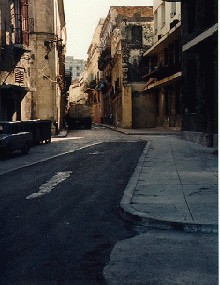
Both strange and fascinating, Cuba’s contradictions seem to extend from
the streets into the very hearts of the people. A young woman who, with
a friend, commandeered us into an acquaintance's paladar (which was
decorated in a beautiful handmade bamboo motif), claimed she hated
Castro because of the changes he'd been making, i.e., allowing dribs
and drabs of private enterprise into the country in an effort to boost
the nation's economy. Her gripe, aside from an increase in crime and
prostitution, was that everything was becoming "dollars, dollars,
dollars." And yet, at meal's end, when we discovered we'd been
seriously overcharged and didn't have enough U.S. dollars to pay the
bill, this woman was the most adamant one there in making sure we paid
in full. We eventually had to cover the difference with Canadian
dollars, to a stream of apologies from the cook.
After our third day in Havana, we headed back to Varadero for a final
24 hours of touching up our tans, trying out a new hotel, and wading in
that soothing emerald sea. With all the walking, heat, and heavy food
(Cuban cuisine is meat-based, and nothing remarkable), it ended up
being a far more exhausting trip than either of us planned. But it was
worth it, if only for our glimpse of a country on the verge of its
biggest tranformation in nearly 40 years. It’s incredible to think of
the untapped potential of that little island—like Central Europe just
before the doors blew open in 1989. Although if Havana is any
indication, Cuba is in far worse shape than even the worst-off former
eastern bloc nation.
Someday, perhaps soon, a lot of people are going to make a lot of money
in Cuba—and from more than selling paint. And while the prospect of a
democratic Cuba is exciting in terms of the nation’s eventual
restoration by capitalism's hands, it's also a little depressing.
Despite the obvious rewards a market economy can offer, does the world
really need more roadsides cluttered with billboards for McDonald's,
Marlboro, and Coke?
